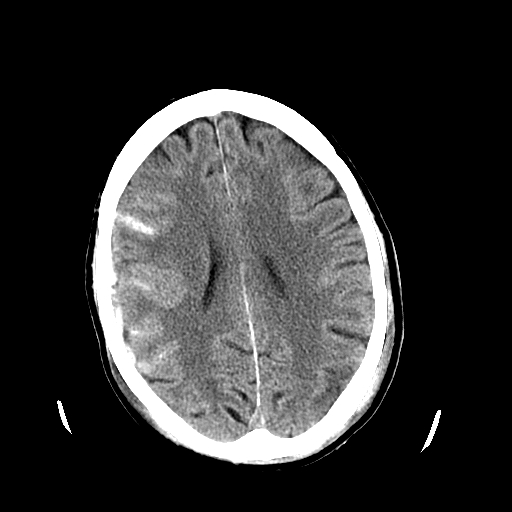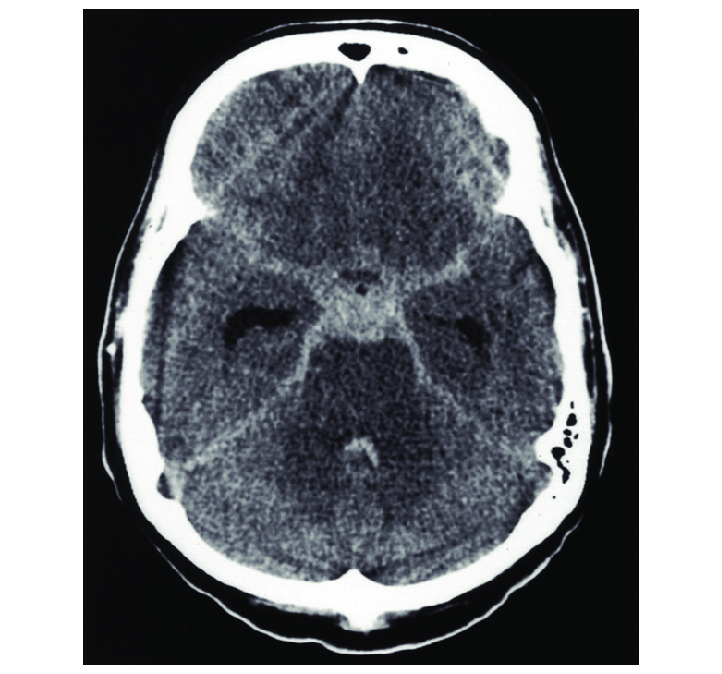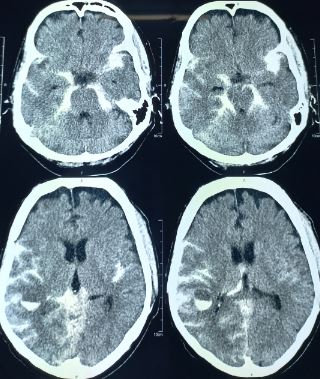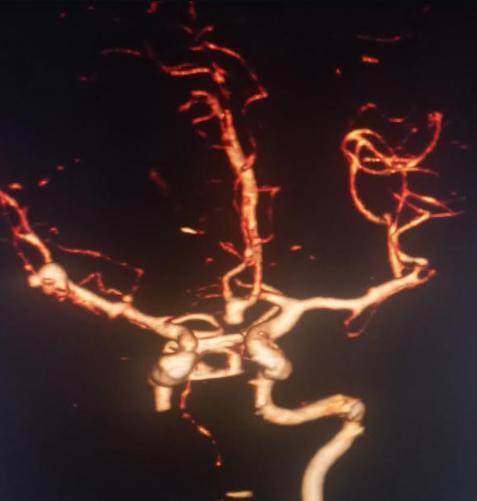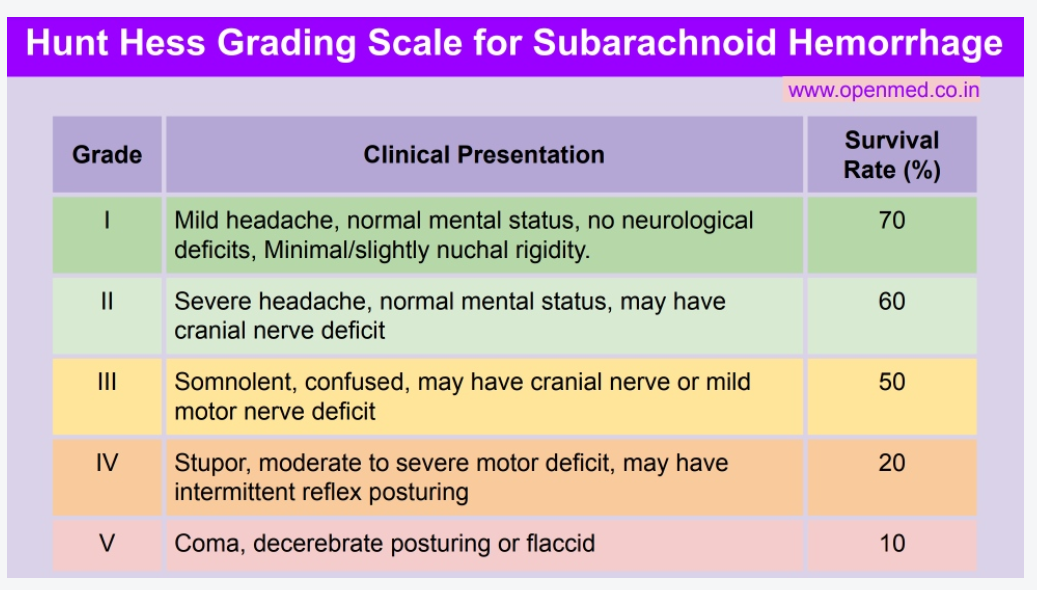[1]
Toth G, Cerejo R. Intracranial aneurysms: Review of current science and management. Vascular medicine (London, England). 2018 Jun:23(3):276-288. doi: 10.1177/1358863X18754693. Epub
[PubMed PMID: 29848228]
[2]
Shea AM, Reed SD, Curtis LH, Alexander MJ, Villani JJ, Schulman KA. Characteristics of nontraumatic subarachnoid hemorrhage in the United States in 2003. Neurosurgery. 2007 Dec:61(6):1131-7; discussion 1137-8
[PubMed PMID: 18162891]
[3]
Rabinstein AA, Lanzino G. Aneurysmal Subarachnoid Hemorrhage: Unanswered Questions. Neurosurgery clinics of North America. 2018 Apr:29(2):255-262. doi: 10.1016/j.nec.2018.01.001. Epub
[PubMed PMID: 29502715]
[4]
van der Jagt M,Hasan D,Bijvoet HW,Pieterman H,Dippel DW,Vermeij FH,Avezaat CJ, Validity of prediction of the site of ruptured intracranial aneurysms with CT. Neurology. 1999 Jan 1
[PubMed PMID: 9921845]
[5]
Olsson S, Csajbok LZ, Jood K, Nylén K, Nellgård B, Jern C. Association between genetic variation on chromosome 9p21 and aneurysmal subarachnoid haemorrhage. Journal of neurology, neurosurgery, and psychiatry. 2011 Apr:82(4):384-8. doi: 10.1136/jnnp.2009.187427. Epub 2010 Oct 25
[PubMed PMID: 20974651]
[6]
Roos YB, Pals G, Struycken PM, Rinkel GJ, Limburg M, Pronk JC, van den Berg JS, Luijten JA, Pearson PL, Vermeulen M, Westerveld A. Genome-wide linkage in a large Dutch consanguineous family maps a locus for intracranial aneurysms to chromosome 2p13. Stroke. 2004 Oct:35(10):2276-81
[PubMed PMID: 15331791]
[7]
Foroud T, Koller DL, Lai D, Sauerbeck L, Anderson C, Ko N, Deka R, Mosley TH, Fornage M, Woo D, Moomaw CJ, Hornung R, Huston J, Meissner I, Bailey-Wilson JE, Langefeld C, Rouleau G, Connolly ES, Worrall BB, Kleindorfer D, Flaherty ML, Martini S, Mackey J, De Los Rios La Rosa F, Brown RD Jr, Broderick JP, FIA Study Investigators. Genome-wide association study of intracranial aneurysms confirms role of Anril and SOX17 in disease risk. Stroke. 2012 Nov:43(11):2846-52. doi: 10.1161/STROKEAHA.112.656397. Epub 2012 Sep 6
[PubMed PMID: 22961961]
[8]
Schievink WI,Schaid DJ,Rogers HM,Piepgras DG,Michels VV, On the inheritance of intracranial aneurysms. Stroke. 1994 Oct;
[PubMed PMID: 8091449]
[9]
Bromberg JE, Rinkel GJ, Algra A, van Duyn CM, Greebe P, Ramos LM, van Gijn J. Familial subarachnoid hemorrhage: distinctive features and patterns of inheritance. Annals of neurology. 1995 Dec:38(6):929-34
[PubMed PMID: 8526466]
[10]
de Rooij NK, Linn FH, van der Plas JA, Algra A, Rinkel GJ. Incidence of subarachnoid haemorrhage: a systematic review with emphasis on region, age, gender and time trends. Journal of neurology, neurosurgery, and psychiatry. 2007 Dec:78(12):1365-72
[PubMed PMID: 17470467]
Level 1 (high-level) evidence
[11]
Feigin V, Parag V, Lawes CM, Rodgers A, Suh I, Woodward M, Jamrozik K, Ueshima H, Asia Pacific Cohort Studies Collaboration. Smoking and elevated blood pressure are the most important risk factors for subarachnoid hemorrhage in the Asia-Pacific region: an overview of 26 cohorts involving 306,620 participants. Stroke. 2005 Jul:36(7):1360-5
[PubMed PMID: 15933249]
Level 3 (low-level) evidence
[12]
Shipman KE, Ramalingam SK, Dawson CH, Yasear ZA. Subarachnoid haemorrhage. Clinical medicine (London, England). 2019 Jan:19(1):88-89. doi: 10.7861/clinmedicine.19-1-88a. Epub
[PubMed PMID: 30651258]
[13]
Hostettler IC, Werring DJ. Acute Convexity Subarachnoid Hemorrhage: What the Neurosurgeon Needs to Know. World neurosurgery. 2019 Mar:123():184-187. doi: 10.1016/j.wneu.2018.12.062. Epub 2018 Dec 21
[PubMed PMID: 30580060]
[14]
Chatterjee S. ECG Changes in Subarachnoid Haemorrhage: A Synopsis. Netherlands heart journal : monthly journal of the Netherlands Society of Cardiology and the Netherlands Heart Foundation. 2011 Jan:19(1):31-4. doi: 10.1007/s12471-010-0049-1. Epub
[PubMed PMID: 22020856]
[15]
Fragata I, Canhão P. Imaging predictors of outcome in acute spontaneous subarachnoid hemorrhage: a review of the literature. Acta radiologica (Stockholm, Sweden : 1987). 2019 Feb:60(2):247-259. doi: 10.1177/0284185118778877. Epub 2018 May 23
[PubMed PMID: 29792042]
[16]
Nelson SE, Sair HI, Stevens RD. Magnetic Resonance Imaging in Aneurysmal Subarachnoid Hemorrhage: Current Evidence and Future Directions. Neurocritical care. 2018 Oct:29(2):241-252. doi: 10.1007/s12028-018-0534-8. Epub
[PubMed PMID: 29633155]
Level 3 (low-level) evidence
[17]
Bederson JB, Connolly ES Jr, Batjer HH, Dacey RG, Dion JE, Diringer MN, Duldner JE Jr, Harbaugh RE, Patel AB, Rosenwasser RH, American Heart Association. Guidelines for the management of aneurysmal subarachnoid hemorrhage: a statement for healthcare professionals from a special writing group of the Stroke Council, American Heart Association. Stroke. 2009 Mar:40(3):994-1025. doi: 10.1161/STROKEAHA.108.191395. Epub 2009 Jan 22
[PubMed PMID: 19164800]
[18]
Jaja BNR, Saposnik G, Lingsma HF, Macdonald E, Thorpe KE, Mamdani M, Steyerberg EW, Molyneux A, Manoel ALO, Schatlo B, Hanggi D, Hasan D, Wong GKC, Etminan N, Fukuda H, Torner J, Schaller KL, Suarez JI, Stienen MN, Vergouwen MDI, Rinkel GJE, Spears J, Cusimano MD, Todd M, Le Roux P, Kirkpatrick P, Pickard J, van den Bergh WM, Murray G, Johnston SC, Yamagata S, Mayer S, Schweizer TA, Macdonald RL, SAHIT collaboration. Development and validation of outcome prediction models for aneurysmal subarachnoid haemorrhage: the SAHIT multinational cohort study. BMJ (Clinical research ed.). 2018 Jan 18:360():j5745. doi: 10.1136/bmj.j5745. Epub 2018 Jan 18
[PubMed PMID: 29348138]
Level 1 (high-level) evidence
[19]
Ogilvy CS, Carter BS. A proposed comprehensive grading system to predict outcome for surgical management of intracranial aneurysms. Neurosurgery. 1998 May:42(5):959-68; discussion 968-70
[PubMed PMID: 9588539]
[20]
Amount of blood on computed tomography as an independent predictor after aneurysm rupture., Brouwers PJ,Dippel DW,Vermeulen M,Lindsay KW,Hasan D,van Gijn J,, Stroke, 1993 Jun
[PubMed PMID: 8506552]
[21]
Okazaki T, Kuroda Y. Aneurysmal subarachnoid hemorrhage: intensive care for improving neurological outcome. Journal of intensive care. 2018:6():28. doi: 10.1186/s40560-018-0297-5. Epub 2018 May 8
[PubMed PMID: 29760928]
[22]
Wang A, Ortega-Gutierrez S, Petersen NH. Autoregulation in the Neuro ICU. Current treatment options in neurology. 2018 May 17:20(6):20. doi: 10.1007/s11940-018-0501-x. Epub 2018 May 17
[PubMed PMID: 29770889]
[23]
Nathan SK, Brahme IS, Kashkoush AI, Anetakis K, Jankowitz BT, Thirumala PD. Risk Factors for In-Hospital Seizures and New-Onset Epilepsy in Coil Embolization of Aneurysmal Subarachnoid Hemorrhage. World neurosurgery. 2018 Jul:115():e523-e531. doi: 10.1016/j.wneu.2018.04.086. Epub 2018 Apr 22
[PubMed PMID: 29689391]
[24]
Pegoli M, Mandrekar J, Rabinstein AA, Lanzino G. Predictors of excellent functional outcome in aneurysmal subarachnoid hemorrhage. Journal of neurosurgery. 2015 Feb:122(2):414-8. doi: 10.3171/2014.10.JNS14290. Epub 2014 Dec 12
[PubMed PMID: 25495745]
[25]
Kistler JP, Crowell RM, Davis KR, Heros R, Ojemann RG, Zervas T, Fisher CM. The relation of cerebral vasospasm to the extent and location of subarachnoid blood visualized by CT scan: a prospective study. Neurology. 1983 Apr:33(4):424-36
[PubMed PMID: 6682190]
[26]
Bøthun ML, Haaland ØA, Logallo N, Svendsen F, Thomassen L, Helland CA. Time Course of Cerebrovascular Reactivity in Patients Treated for Unruptured Intracranial Aneurysms: A One-Year Transcranial Doppler and Acetazolamide Follow-Up Study. BioMed research international. 2018:2018():6489276. doi: 10.1155/2018/6489276. Epub 2018 Apr 26
[PubMed PMID: 29854773]
[27]
Hijdra A, van Gijn J, Nagelkerke NJ, Vermeulen M, van Crevel H. Prediction of delayed cerebral ischemia, rebleeding, and outcome after aneurysmal subarachnoid hemorrhage. Stroke. 1988 Oct:19(10):1250-6
[PubMed PMID: 3176085]
[28]
Frontera JA, Claassen J, Schmidt JM, Wartenberg KE, Temes R, Connolly ES Jr, MacDonald RL, Mayer SA. Prediction of symptomatic vasospasm after subarachnoid hemorrhage: the modified fisher scale. Neurosurgery. 2006 Jul:59(1):21-7; discussion 21-7
[PubMed PMID: 16823296]
[29]
Broderick JP, Brott TG, Duldner JE, Tomsick T, Leach A. Initial and recurrent bleeding are the major causes of death following subarachnoid hemorrhage. Stroke. 1994 Jul:25(7):1342-7
[PubMed PMID: 8023347]
[30]
Booij HA, Gaykema WDC, Kuijpers KAJ, Pouwels MJM, den Hertog HM. Pituitary dysfunction and association with fatigue in stroke and other acute brain injury. Endocrine connections. 2018 Jun:7(6):R223-R237. doi: 10.1530/EC-18-0147. Epub 2018 May 10
[PubMed PMID: 29748174]
[31]
Gruenbaum SE, Bilotta F. Postoperative ICU management of patients after subarachnoid hemorrhage. Current opinion in anaesthesiology. 2014 Oct:27(5):489-93. doi: 10.1097/ACO.0000000000000111. Epub
[PubMed PMID: 25115766]
Level 3 (low-level) evidence
[32]
Ikawa F, Michihata N, Matsushige T, Abiko M, Ishii D, Oshita J, Okazaki T, Sakamoto S, Kurogi R, Iihara K, Nishimura K, Morita A, Fushimi K, Yasunaga H, Kurisu K. In-hospital mortality and poor outcome after surgical clipping and endovascular coiling for aneurysmal subarachnoid hemorrhage using nationwide databases: a systematic review and meta-analysis. Neurosurgical review. 2020 Apr:43(2):655-667. doi: 10.1007/s10143-019-01096-2. Epub 2019 Apr 2
[PubMed PMID: 30941595]
Level 1 (high-level) evidence

